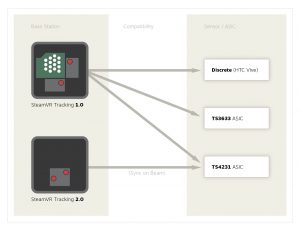I received some bitter sweet news today from the folks at Valve Software.
After much anticipation, the engineers at SteamVR have found a way to create a cheaper, more versatile Lighthouse solution. The old sensor chip, the TS3633, produced a single “envelope” pulse per laser or sync blinker hit. That hit allows the Watchman module in the device to time the difference between the sync and the laser hit and compute angle from that difference. There is a new sensor chip from Triad Semiconductor, the TS4231 which is actually simpler and cheaper to produce. What’s most important, it provides a burst of data per laser or sync hit. Using that data allows information to be transmitted on the laser itself, which we can be used to learn about the source of that laser.
This new capability to encode information in the laser is significant for two reasons:
- It allows support for more than two base stations, and thus larger tracking volumes.
- It allows a base station to function without including a sync blinker, which is the source of most of the interference between base stations (and is also a significant driver of base station cost.) This technology is called sync-on-beam.
Depending on tests, these new sensors will start rolling out in late June. The new lighthouses won’t start rolling out until November.
Here is a diagram of the compatibility of the two systems:

Regretfully the old sensors will not work with the new Light House configuration. The new sensors will work with the old but not the other way around. Regretfully I just invested in 7 new Tracker pucks. They can still be used with the old system but not the new.
So this news is bitter sweet. iMyth will have ware house scale VR in 2018. Regretfully We will need to retrofit will all new sensors. I suppose it was a good thing I had not had a chance to turn the printed iMyth props into controllers since they will be need to be redone anyway. At close to $500 per prop, I suppose the damage could have been much worse. I have recently finished long conversations with the folks at Optitrack and Motion Reality. It seems now Steam VR can join them in the House Scale/Warehouse Scale VR race. Because Steam VR tracking is not bound by cameras, there may be possibility to have vertical structures as well. Very cool!